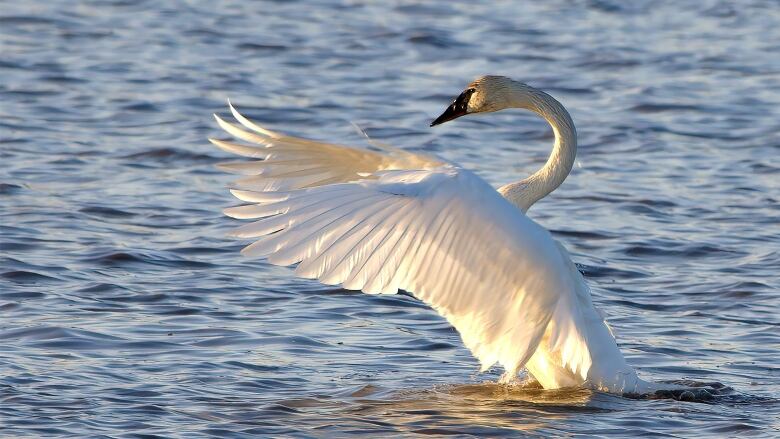The 'profound, beautiful' waterbirds that have been brought back from the brink
Naturalist Brian Keating says trumpeter swans have come back from very low numbers of population

Known for their shyness, it's not easy to get a good glimpse of the largest migratory bird in North America. But that means that when it happens, it's all the more impactful.
Naturalist Brian Keating said over the last couple of years, he has seen trumpeter swans in the city of Calgary flying up and down the Bow River.
When it happens, he said it fills his heart with joy.
"They're a profound, beautiful, iconic waterbird that we equate with beauty. I mean, you look at these swans, they're so graceful, they're so big, they're so white, they're incredible," Keating said.
"They're shy, too. So they're not easy to approach. And I think that just makes them that much more alluring."
It takes a lot of work to get a good sighting of these birds — or a long, powerful telescope.

In Keating's view, the increased presence of the trumpeter swan in the province is one of the real success stories in Alberta's backyard.
"We've got good boreal forest lake environments that are numerous, that are very low human population. And these birds need those quiet areas to breed and successfully reproduce," Keating said.
Trumpeter swans don't like lakes with motorboats or areas with heavy human activity — making northern Alberta a suitable habitat.
"They've come back from very low numbers. In the United States, their population was around 70. Now, the population is up over 50,000," Keating said. "We have so many sad stories out there … but this shows us that we can do amazing things if we put our mind to it.
"This is a bird that we nearly lost, and it's coming back in good numbers. And it's because Alberta is still a good place to set up shop and raise your youngsters."
A perilous migration
There are several populations of trumpeter swans in the United States, but the significant population is related to Yellowstone National Park, Keating said.
"That used to be where the epicentre of birds was and there's been other populations that have developed since where they migrate to," Keating said. "The remnant population existed in Yellowstone in some hot spring-heated areas that allowed the birds to overwinter.
"It's from that population that our North American population managed to survive."
The birds migrate from the United States up to Canada and then back down — but migration can be dangerous.
For example, swans are at risk at being killed after running into power lines and are subject to natural dangers like eagles taking them out of the skies.

Keating said he has already seen a flock of 200 swans this spring east of Calgary near Weed Lake.
"Last week, we heard hundreds of swans and saw dozens," he said. "We could hear them calling like crazy from the far end of the lake.
"But yeah, the swans are out right now and they're easily seen all around lakes and ponds all around Calgary. Piece of cake."
Keating recommended taking a pair of binoculars or a spotting scope should you be seeking to spot a flock of the bashful bird.




For more about Alberta's wildlife from naturalist Brian Keating, check out Great Big Nature and check out these stories: